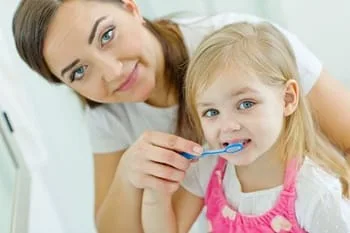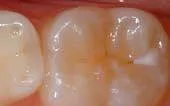Care Of Your Child’s Teeth

Brushing Tips:
- Starting at birth, clean your child’s gums with a soft cloth and water.
- As soon as your child’s teeth erupt, brush them with a soft-bristled toothbrush.
- If they are under the age of 2, use a small smear of toothpaste.
- If they’re 2-5 years old, use a pea-size amount of toothpaste.
- Be sure and use an ADA-accepted fluoride toothpaste and make sure your child does not swallow it.
- The parent should brush the child’s teeth until they are old enough to do a good job on their own.
Flossing Tips:
- Flossing removes plaque between teeth and under the gumline where a toothbrush can’t reach.
- Flossing should begin when any two teeth touch.
- Be sure and floss your child’s teeth daily until he or she can do it alone.
Good Diet = Healthy Teeth

Healthy eating habits lead to healthy teeth. Like the rest of the body, teeth, bones and the soft tissues of the mouth need a well-balanced diet. Children should eat a variety of foods from the five major food groups. Most pre-packaged snacks that children eat can lead to cavity formation. Thus, the more frequently a child snacks, the greater the chance for tooth decay. How long food remains in the mouth also plays a role. For example, hard candy and breath mints stay in the mouth a long time, which cause longer acid attacks on tooth enamel. If your child must snack, choose nutritious foods such as vegetables, low-fat yogurt, and low-fat cheese, which are healthier and better for children’s teeth.
How Do I Prevent Cavities?
Good oral hygiene removes bacteria and the left over food particles that combine to create cavities. For infants, use a wet gauze or clean washcloth to wipe the plaque from teeth and gums. Avoid putting your child to bed with a bottle filled with anything other than water. See “Baby Bottle Tooth Decay” for more information.
For older children, brush their teeth at least twice a day for two minutes at a time. Also, watch the number of snacks containing sugar that you give your children.
The American Academy of Pediatric Dentistry recommends visiting the dentist every six months, beginning at your child’s first birthday. Routine visits will start your child on a lifetime of good dental health.
Your pediatric dentist may also recommend protective sealants or home fluoride treatments for your child. Sealants can be applied to your child’s molars to prevent decay on hard to clean surfaces.
Seal Out Decay
A sealant is a protective coating that is applied to the chewing surfaces of the back teeth (premolars and molars), where four out of five cavities in children are found. Sealant acts as a barrier to food, plaque and acid, thus protecting the decay-prone areas of the teeth.

Before Sealant Applied

After Sealant Applied
Fluoride
Fluoride is a naturally occurring element which has shown to prevent tooth decay by as much as 50-70%. For children younger than 8 years old, fluoride actually helps strengthen the adult teeth that are developing beneath their gums. With little or no fluoride, teeth aren’t strengthened enough to help them resist cavities. Excessive fluoride ingestion by young children can lead to dental fluorosis, which is a white discoloration (brown in advanced cases) of the permanent teeth.
The two primary sources of fluoride are fluoridated water and toothpaste. Fluoridated water is most commonly found in local tap water. Dentists encourage drinking tap water from the sink because a number of water dispensing refrigerators filter out up to 90% of fluoride found in local water. However, charcoal and carbon type water filters such as a Britta filter retain fluoride levels found in local water while still providing filtered drinking water.
For children beneath 3 years of age, use a smear of fluoride toothpaste (the size of a grain of rice) to brush their teeth. For children 3 to 6 years old, use a “pea-size” amount of toothpaste and perform or assist your child’s tooth brushing. To ensure that your child’s toothpaste contains the optimal amount of fluoride, look for the ADA seal of acceptance somewhere on the packaging. Children should not swallow excess toothpaste after brushing, in order to avoid fluorosis. Be sure to follow your pediatric dentist’s instructions on suggested fluoride use and possible supplements.
Awareness of a child’s potential sources of fluoride can help parents prevent the possibility of dental fluorosis.
Some sources of fluoride are:
- Fluoridated toothpaste.
- Fluoride supplements.
- Tap water.
Two and three-year olds may not be able to spit out toothpaste when brushing. As a result, younger children may ingest an excessive amount of fluoride when brushing. Toothpaste ingestion during this period of permanent tooth development is the greatest risk factor for developing of fluorosis.
Excessive intake of fluoride supplements may also contribute to fluorosis. Fluoride drops and tablets, as well as fluoride fortified vitamins should not be given to infants younger than six months of age. After that time, fluoride supplements should only be given to children after all of the sources of ingested fluoride have been accounted for and upon the recommendation of your pediatrician or pediatric dentist.
Certain foods contain high levels of fluoride, especially: powdered concentrate infant formula, soy-based infant formula, infant dry cereals, creamed spinach, and infant chicken products. Please read the label or contact the manufacturer to learn more about the fluoride levels in specific foods.
Some beverages also contain high levels of fluoride, especially: decaffeinated teas, white grape juices, and juice drinks manufactured in fluoridated cities. Soft drinks served at restraurants may also contain fluoride, depending upon the fluoridation levels in their local water supply.
Parents can take the following steps to decrease the risk of fluorosis in their children’s teeth:
- Use baby teeth cleanser on a toothbrush in very young children.
- Use only a pea-sized drop of children’s toothpaste when brushing.
- Account for all of the sources of ingested fluoride before requesting fluoride supplements from your child’s physician or pediatric dentist.
- Avoid giving any fluoride supplements to infants until they are at least 6 months old.
- Obtain fluoride level test results for your drinking water before giving fluoride supplements to your child. To do this, check with local water utilities.
Mouth Guards

Oral injuries can occur if you participate in recreational activities and organized sports. Which makes a properly fitted mouth guard – or mouth protector – an important piece of athletic gear that can help protect your smile. A mouth guard should be used during any activity that could result in a blow to the face or mouth.
Mouth guards help prevent broken teeth, injuries to the lips, tongue, face, and jaw. A properly fitted mouth guard will stay in place while you’re wearing it, making it easy for you to talk and breathe.
Ask your dentist about custom and store-bought mouth protectors.
Xylitol – Reducing Cavities
The American Academy of Pediatric Dentistry (AAPD) recognizes the benefits of xylitol for the oral health of infants, children, adolescents, and persons with special health care needs.
Mothers chewing xylitol gum 2-4 times per day can reduce cavities up to 70% in their children aged 3 months to 5 years.
Studies using xylitol as either a sugar substitute or a small dietary addition have demonstrated a dramatic reduction in new tooth decay, and some reversal of existing dental cavities. Xylitol provides additional protection that enhances all existing prevention methods. The xylitol effect is long-lasting and possibly permanent. Low decay rates persisted years after the trials completed.
Xylitol is distributed throughout nature in small amounts. Some great sources of xylitol are fruits, berries, mushrooms, lettuce, hardwoods, and corn on the cob. One cup of raspberries contains less than one gram of xylitol.
Studies suggest that consuming 4-20 grams of xylitol per day divided into 3-7 consumption periods produces the most positive results. Greater results did not occur in larger consumption and may lead to diminishing results. Similarly, consumption frequency of less than 3 times per day showed no effect.
Visit your local health food store or search online to find products containing 100% xylitol. Consult your dentist about xylitol, and the amount you should specifically consume.
Beware of Sports Drinks
Sports drinks have erosive properties and the ability to dissolve fluoride-rich enamel that can lead to cavities. The negative effects of sports drinks are due to the dense sugar content and the high amount of acid.
Children should avoid sports drinks and hydrate with water before, during and after sports to minimize dental problems. Be sure to talk to your pediatric dentist before consuming sports drinks.
If sports drinks are consumed:
- Reduce the frequency and contact time.
- Swallow immediately and do not swish them around the mouth.
- Neutralize the effect of sports drinks by alternating sips of water with the drink.
- Rinse mouthguards only in water.
- Seek out dentally friendly sports drinks.
- Consider diluting sports drinks with 50% water.
